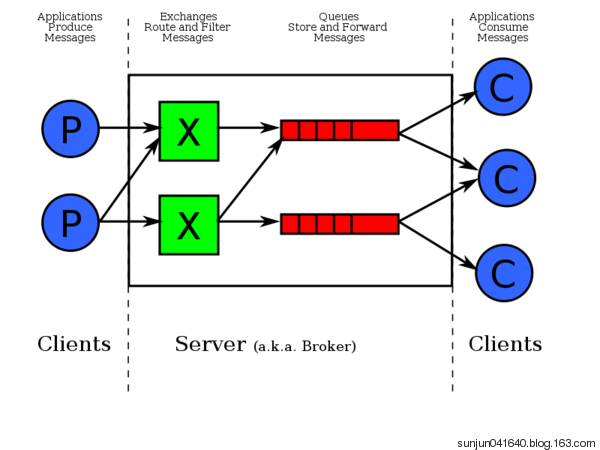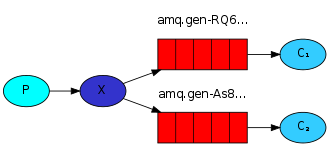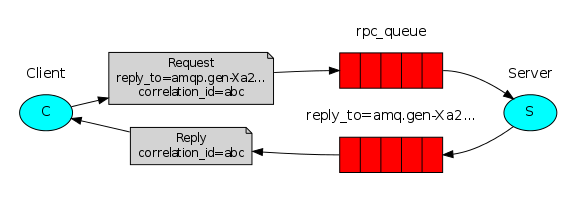网络编程之异步IO,rabbitMQ笔记
对于网络并发编程而言,多线程与多进程算是最常见的需求场景了。毕竟网站开放就是想要更多的流量访问的。
回顾
回顾下之前学过的关于线程,进程和协程的知识点
IO密集型任务--用多线程更好
计算密集型任务--用多进程更好
线程概念:计算机中工作的最小单元
进程:默认有主线程,可以有多线程共存,并共享内存资源。
协程:使用进程中的一个线程去做多个任务,微线程pypy
GIL:全局解释器锁,python特有,用于在进程中对所有线程加锁,保证同时只能有一个线程被CPU调度
一句话说明什么是协程:协程是一种用户态的轻量级线程。
协程的特点:协程能保留上一次调用时的状态(即所有局部状态的一个特定组合),每次过程重入时,就相当于进入上一次调用的状态,换种说法:进入上一次离开时所处逻辑流的位置。
那么符合什么条件我们可以称之为协程?
协程需要满足四个条件:
- 必须在只有一个单线程里实现并发
- 修改共享数据不需加锁
- 用户程序里自己保存多个控制流的上下文栈
- 一个协程遇到IO操作自动切换到其它协程
当然,协程也有自身的优缺点,这里不展开。
在python中,我们可以轻松通过gevent实现并发同步或异步编程,在gevent中用到的主要模式是Greenlet, 它是以C扩展模块形式接入Python的轻量级协程。 Greenlet全部运行在主程序操作系统进程的内部,但它们被协作式地调度。
论事件驱动与异步
异步IO
Python中的select模块专注于I/O多路复用,提供了select poll epoll三个方法(其中后两个在Linux中可用,windows仅支持select),另外也提供了kqueue方法(freeBSD系统)
select模块
select的优点在于,跨平台支持良好。问题在于,select问题在于单个进程能够监视的文件描述符的数量存在最大限制,在Linux上一般为1024;且select()所维护的存储大量文件描述符的数据结构,随着文件描述符数量的增大,其复制的开销也线性增长。
poll模块
poll和select本质上没有区别,区别在于没有最大文件描述符数量的限制。它的缺是点包含大量文件描述符的数组被整体复制于用户态和内核的地址空间之间,而不论这些文件描述符是否就绪,它的开销随着文件描述符数量的增加而线性增大。
epoll
epoll可同时支持水平触发和边缘触发,理论上边缘触发实现性能更高,但代码实现复杂。
epoll相对于select的改进有两点:
1.epoll同样只告知那些就绪的文件描述符,而且当我们调用epoll_wait()获得就绪文件描述符时,返回的不是实际的描述符,而是一个代表就绪描述符数量的值,这里使用了内存映射的技术,节省了文件描述符在系统调用时复制的开销。
2.另一个本质的改进在于epoll采用基于事件的就绪通知方式。epoll事先通过epoll_ctl()来注册一个文件描述符,一旦基于某个文件描述符就绪时,内核会采用类似callback的回调机制,迅速激活这个文件描述符,当进程调用epoll_wait()时便得到通知。
进程切换的概念
为了控制进程的执行,内核必须有能力挂起正在CPU上运行的进程,并恢复以前挂起的某个进程的执行。这种行为被称为进程切换。因此可以说,任何进程都是在操作系统内核的支持下运行的,是与内核紧密相关的。
但进程切换十分消耗OS资源。对于进程流,会在请求系统未响应或是等待某种操作完成时,系统自动执行阻塞原语,使自己由运行状态转变为阻塞状态。
进程的阻塞是进程自身的一种主动行为,也因此只有处于运行态的进程(获得CPU),才可能将其转为阻塞状态。当进程进入阻塞状态,是不占用CPU资源的。
了解水平触发和边缘触发:
Level_triggered(水平触发,有时也称条件触发):当被监控的文件描述符上有可读写事件发生时,epoll.poll()会通知处理程序去读写。如果这次没有把数据一次性全部读写完(如读写缓冲区太小),那么下次调用 epoll.poll()时,它还会通知你在上没读写完的文件描述符上继续读写,当然如果你一直不去读写,它会一直通知你!!!如果系统中有大量你不需要读写的就绪文件描述符,而它们每次都会返回,这样会大大降低处理程序检索自己关心的就绪文件描述符的效率!!! 优点很明显:稳定可靠
Edge_triggered(边缘触发,有时也称状态触发):当被监控的文件描述符上有可读写事件发生时,epoll.poll()会通知处理程序去读写。如果这次没有把数据全部读写完(如读写缓冲区太小),那么下次调用epoll.poll()时,它不会通知你,也就是它只会通知你一次,直到该文件描述符上出现第二次可读写事件才会通知你!!!这种模式比水平触发效率高,系统不会充斥大量你不关心的就绪文件描述符!!!缺点:某些条件下不可靠
epoll事件:
EPOLLIN Available for read 可读 状态符为1
EPOLLOUT Available for write 可写 状态符为4
EPOLLPRI Urgent data for read
EPOLLERR Error condition happened on the assoc. fd 发生错误 状态符为8
EPOLLHUP Hang up happened on the assoc. fd 挂起状态
EPOLLET Set Edge Trigger behavior, the default is Level Trigger behavior 默认为水平触发,设置该事件后则边缘触发
EPOLLONESHOT Set one-shot behavior. After one event is pulled out, the fd is internally disabled
EPOLLRDNORM Equivalent to EPOLLIN
EPOLLRDBAND Priority data band can be read.
EPOLLWRNORM Equivalent to EPOLLOUT
EPOLLWRBAND Priority data may be written.
EPOLLMSG Ignored.
Python select
python中的select方法直接调用系统的IO接口,它监控特定的文件句柄何时变成readable和writeable,或通信错误,select()使得监控多个连接变得简单。
RabbitMQ
rabbitMQ是消息队列;想想之前的我们学过队列queue:threading queue(线程queue,多个线程之间进行数据交互)、进程queue(父进程与子进程进行交互或者同属于同一父进程下的多个子进程进行交互);如果两个独立的程序,那么之间是不能通过queue进行交互的,这时候我们就需要一个中间代理即rabbitMQ。一般用于Linux服务器
消息队列:
- RabbitMQ
- ZeroMQ
- ActiveMQ
- .......
工作原理:

安装和使用
python安装rabbitMQ模块
pip install pika
or
easy_install pika
or
源码 https://pypi.python.org/pypi/pika
实例:最简单的通信队列实现
发送端
#!/usr/bin/env python
# -*- coding:utf-8 -*-
#-Author-Lian import pika connection = pika.BlockingConnection(pika.ConnectionParameters('localhost')) channel = connection.channel() #声明一个管道(管道内发消息) channel.queue_declare(queue='lzl') #声明queue队列 channel.basic_publish(exchange='',
routing_key='lzl', #routing_key 就是queue名
body='Hello World!'
)
print("Sent 'Hello,World!'")
connection.close() #关闭
接收端
#!/usr/bin/env python
# -*- coding:utf-8 -*-
#-Author-Lian import pika connection = pika.BlockingConnection(pika.ConnectionParameters('localhost')) channel = connection.channel() channel.queue_declare(queue='lzl') def callback(ch,method,properties,body):
print(ch,method,properties)
#ch:<pika.adapters.blocking_connection.BlockingChannel object at 0x002E6C90> 管道内存对象地址
#methon:<Basic.Deliver(['consumer_tag=ctag1.03d155a851b146f19cee393ff1a7ae38', #具体信息
# 'delivery_tag=1', 'exchange=', 'redelivered=False', 'routing_key=lzl'])>
#properties:<BasicProperties>
print("Received %r"%body) channel.basic_consume(callback, #如果收到消息,就调用callback函数处理消息
queue="lzl",
no_ack=True) #接受到消息后不返回ack,无论本地是否处理完消息都会在队列中消失
print(' [*] Waiting for messages. To exit press CTRL+C')
channel.start_consuming() #开始收消息
注:windows连linux上的rabbitMQ会出现报错,需要提供用户名密码
3、RabbitMQ消息分发轮询
先启动消息生产者,然后再分别启动3个消费者,通过生产者多发送几条消息,你会发现,这几条消息会被依次分配到各个消费者身上

在这种模式下,RabbitMQ会默认把p发的消息公平的依次分发给各个消费者(c),跟负载均衡差不多
#!/usr/bin/env python
# -*- coding:utf-8 -*-
#-Author-Lian import pika connection = pika.BlockingConnection(pika.ConnectionParameters('localhost')) channel = connection.channel() #声明一个管道(管道内发消息) channel.queue_declare(queue='lzl') #声明queue队列 channel.basic_publish(exchange='',
routing_key='lzl', #routing_key 就是queue名
body='Hello World!'
)
print("Sent 'Hello,World!'")
connection.close() #关闭
pubulish.py
#!/usr/bin/env python
# -*- coding:utf-8 -*-
#-Author-Lian import pika connection = pika.BlockingConnection(pika.ConnectionParameters('localhost')) channel = connection.channel() channel.queue_declare(queue='lzl') def callback(ch,method,properties,body):
print(ch,method,properties)
#ch:<pika.adapters.blocking_connection.BlockingChannel object at 0x002E6C90> 管道内存对象地址
#methon:<Basic.Deliver(['consumer_tag=ctag1.03d155a851b146f19cee393ff1a7ae38', #具体信息
# 'delivery_tag=1', 'exchange=', 'redelivered=False', 'routing_key=lzl'])>
#properties:<BasicProperties>
print("Received %r"%body) channel.basic_consume(callback, #如果收到消息,就调用callback函数处理消息
queue="lzl",
no_ack=True)
print(' [*] Waiting for messages. To exit press CTRL+C')
channel.start_consuming() #开始收消息
consume.py
通过执行pubulish.py和consume.py可以实现上面的消息公平分发,那假如c1收到消息之后宕机了,会出现什么情况呢?rabbitMQ是如何处理的?现在我们模拟一下
#!/usr/bin/env python
# -*- coding:utf-8 -*-
#-Author-Lian import pika connection = pika.BlockingConnection(pika.ConnectionParameters('localhost')) channel = connection.channel() #声明一个管道(管道内发消息) channel.queue_declare(queue='lzl') #声明queue队列 channel.basic_publish(exchange='',
routing_key='lzl', #routing_key 就是queue名
body='Hello World!'
)
print("Sent 'Hello,World!'")
connection.close() #关闭
publish.py
#!/usr/bin/env python
# -*- coding:utf-8 -*-
#-Author-Lian import pika,time connection = pika.BlockingConnection(pika.ConnectionParameters('localhost')) channel = connection.channel() channel.queue_declare(queue='lzl') def callback(ch,method,properties,body):
print("->>",ch,method,properties)
time.sleep(15) # 模拟处理时间
print("Received %r"%body) channel.basic_consume(callback, #如果收到消息,就调用callback函数处理消息
queue="lzl",
no_ack=True)
print(' [*] Waiting for messages. To exit press CTRL+C')
channel.start_consuming() #开始收消息
consume.py
在consume.py的callback函数里增加了time.sleep模拟函数处理,通过上面程序进行模拟发现,c1接收到消息后没有处理完突然宕机,消息就从队列上消失了,rabbitMQ把消息删除掉了;如果程序要求消息必须要处理完才能从队列里删除,那我们就需要对程序进行处理一下
#!/usr/bin/env python
# -*- coding:utf-8 -*-
#-Author-Lian import pika connection = pika.BlockingConnection(pika.ConnectionParameters('localhost')) channel = connection.channel() #声明一个管道(管道内发消息) channel.queue_declare(queue='lzl') #声明queue队列 channel.basic_publish(exchange='',
routing_key='lzl', #routing_key 就是queue名
body='Hello World!'
)
print("Sent 'Hello,World!'")
connection.close() #关闭
publish.py
#!/usr/bin/env python
# -*- coding:utf-8 -*-
#-Author-Lian import pika,time connection = pika.BlockingConnection(pika.ConnectionParameters('localhost')) channel = connection.channel() channel.queue_declare(queue='lzl') def callback(ch,method,properties,body):
print("->>",ch,method,properties)
#time.sleep(15) # 模拟处理时间
print("Received %r"%body)
ch.basic_ack(delivery_tag=method.delivery_tag) channel.basic_consume(callback, #如果收到消息,就调用callback函数处理消息
queue="lzl",
)
print(' [*] Waiting for messages. To exit press CTRL+C')
channel.start_consuming() #开始收消息
consume.py
通过把consume.py接收端里的no_ack=True去掉之后并在callback函数里面添加ch.basic_ack(delivery_tag = method.delivery_tag,就可以实现消息不被处理完不能在队列里清除
查看消息队列数:

4、消息持久化
如果消息在传输过程中rabbitMQ服务器宕机了,会发现之前的消息队列就不存在了,这时我们就要用到消息持久化,消息持久化会让队列不随着服务器宕机而消失,会永久的保存下去
发送端:
# -*- coding:utf-8 -*-
#-Author-Lian import pika connection = pika.BlockingConnection(pika.ConnectionParameters('localhost')) channel = connection.channel() #声明一个管道(管道内发消息) channel.queue_declare(queue='lzl',durable=True) #队列持久化 channel.basic_publish(exchange='',
routing_key='lzl', #routing_key 就是queue名
body='Hello World!',
properties=pika.BasicProperties(
delivery_mode = 2 #消息持久化
)
)
print("Sent 'Hello,World!'")
connection.close() #关闭
接收端:
#!/usr/bin/env python
# -*- coding:utf-8 -*-
#-Author-Lian import pika,time connection = pika.BlockingConnection(pika.ConnectionParameters('localhost')) channel = connection.channel() channel.queue_declare(queue='lzl',durable=True) def callback(ch,method,properties,body):
print("->>",ch,method,properties)
time.sleep(15) # 模拟处理时间
print("Received %r"%body)
ch.basic_ack(delivery_tag=method.delivery_tag) channel.basic_consume(callback, #如果收到消息,就调用callback函数处理消息
queue="lzl",
)
print(' [*] Waiting for messages. To exit press CTRL+C')
channel.start_consuming() #开始收消息
5、消息公平分发
如果Rabbit只管按顺序把消息发到各个消费者身上,不考虑消费者负载的话,很可能出现,一个机器配置不高的消费者那里堆积了很多消息处理不完,同时配置高的消费者却一直很轻松。为解决此问题,可以在各个消费者端,配置perfetch=1,意思就是告诉RabbitMQ在我这个消费者当前消息还没处理完的时候就不要再给我发新消息了

channel.basic_qos(prefetch_count=1)
带消息持久化+公平分发
#!/usr/bin/env python
# -*- coding:utf-8 -*-
#-Author-Lian import pika connection = pika.BlockingConnection(pika.ConnectionParameters('localhost')) channel = connection.channel() #声明一个管道(管道内发消息) channel.queue_declare(queue='lzl',durable=True) #队列持久化 channel.basic_publish(exchange='',
routing_key='lzl', #routing_key 就是queue名
body='Hello World!',
properties=pika.BasicProperties(
delivery_mode = 2 #消息持久化
)
)
print("Sent 'Hello,World!'")
connection.close() #关闭
pubulish.py
#!/usr/bin/env python
# -*- coding:utf-8 -*-
#-Author-Lian import pika,time connection = pika.BlockingConnection(pika.ConnectionParameters('localhost')) channel = connection.channel() channel.queue_declare(queue='lzl',durable=True) def callback(ch,method,properties,body):
print("->>",ch,method,properties)
time.sleep(15) # 模拟处理时间
print("Received %r"%body)
ch.basic_ack(delivery_tag=method.delivery_tag) channel.basic_qos(prefetch_count=1)
channel.basic_consume(callback, #如果收到消息,就调用callback函数处理消息
queue="lzl",
)
print(' [*] Waiting for messages. To exit press CTRL+C')
channel.start_consuming() #开始收消息
consume.py
6、Publish\Subscribe(消息发布\订阅)
之前的例子都基本都是1对1的消息发送和接收,即消息只能发送到指定的queue里,但有些时候你想让你的消息被所有的Queue收到,类似广播的效果,这时候就要用到exchange了,
An exchange is a very simple thing. On one side it receives messages from producers and the other side it pushes them to queues. The exchange must know exactly what to do with a message it receives. Should it be appended to a particular queue? Should it be appended to many queues? Or should it get discarded. The rules for that are defined by the exchange type.
Exchange在定义的时候是有类型的,以决定到底是哪些Queue符合条件,可以接收消息
fanout: 所有bind到此exchange的queue都可以接收消息
direct: 通过routingKey和exchange决定的那个唯一的queue可以接收消息
topic:所有符合routingKey(此时可以是一个表达式)的routingKey所bind的queue可以接收消息
headers: 通过headers 来决定把消息发给哪些queue
表达式符号说明:#代表一个或多个字符,*代表任何字符
例:#.a会匹配a.a,aa.a,aaa.a等
*.a会匹配a.a,b.a,c.a等
注:使用RoutingKey为#,Exchange Type为topic的时候相当于使用fanout
① fanout接收所有广播:广播表示当前消息是实时的,如果没有一个消费者在接受消息,消息就会丢弃,在这里消费者的no_ack已经无用,因为fanout不会管你处理消息结束没有,发过的消息不会重发,记住广播是实时的

#!/usr/bin/env python
# -*- coding:utf-8 -*-
#-Author-Lian import pika
import sys connection = pika.BlockingConnection(pika.ConnectionParameters(
host='localhost'))
channel = connection.channel() channel.exchange_declare(exchange='logs',
type='fanout') message = "info: Hello World!"
channel.basic_publish(exchange='logs',
routing_key='', #广播不用声明queue
body=message)
print(" [x] Sent %r" % message)
connection.close()
publish.py
#!/usr/bin/env python
# -*- coding:utf-8 -*-
#-Author-Lian import pika connection = pika.BlockingConnection(pika.ConnectionParameters(
host='localhost'))
channel = connection.channel() channel.exchange_declare(exchange='logs',
type='fanout') result = channel.queue_declare(exclusive=True) # 不指定queue名字,rabbit会随机分配一个名字,
# exclusive=True会在使用此queue的消费者断开后,自动将queue删除
queue_name = result.method.queue channel.queue_bind(exchange='logs', # 绑定转发器,收转发器上面的数据
queue=queue_name) print(' [*] Waiting for logs. To exit press CTRL+C') def callback(ch, method, properties, body):
print(" [x] %r" % body) channel.basic_consume(callback,
queue=queue_name,
no_ack=True)
channel.start_consuming()
consume.py
② 有选择的接收消息 direct: 同fanout一样,no_ack在此要设置为True,不然队列里数据不会清空(虽然也不会重发)
RabbitMQ还支持根据关键字发送,即:队列绑定关键字,发送者将数据根据关键字发送到消息exchange,exchange根据 关键字 判定应该将数据发送至指定队列

import pika
import sys connection = pika.BlockingConnection(pika.ConnectionParameters(
host='localhost'))
channel = connection.channel() channel.exchange_declare(exchange='direct_logs',
type='direct') severity = sys.argv[1] if len(sys.argv) > 1 else 'info'
message = ' '.join(sys.argv[2:]) or 'Hello World!'
channel.basic_publish(exchange='direct_logs',
routing_key=severity,
body=message)
print(" [x] Sent %r:%r" % (severity, message))
connection.close()
publish.py
import pika
import sys connection = pika.BlockingConnection(pika.ConnectionParameters(
host='localhost'))
channel = connection.channel() channel.exchange_declare(exchange='direct_logs',
type='direct') result = channel.queue_declare(exclusive=True)
queue_name = result.method.queue severities = sys.argv[1:]
if not severities:
sys.stderr.write("Usage: %s [info] [warning] [error]\n" % sys.argv[0])
sys.exit(1) for severity in severities:
channel.queue_bind(exchange='direct_logs',
queue=queue_name,
routing_key=severity) print(' [*] Waiting for logs. To exit press CTRL+C') def callback(ch, method, properties, body):
print(" [x] %r:%r" % (method.routing_key, body)) channel.basic_consume(callback,
queue=queue_name,
no_ack=True) channel.start_consuming()
consume.py
③ 更细致的消息过滤 topic:
Although using the direct exchange improved our system, it still has limitations - it can't do routing based on multiple criteria.
In our logging system we might want to subscribe to not only logs based on severity, but also based on the source which emitted the log. You might know this concept from the syslog unix tool, which routes logs based on both severity (info/warn/crit...) and facility (auth/cron/kern...).
That would give us a lot of flexibility - we may want to listen to just critical errors coming from 'cron' but also all logs from 'kern'

import pika
import sys connection = pika.BlockingConnection(pika.ConnectionParameters(
host='localhost'))
channel = connection.channel() channel.exchange_declare(exchange='topic_logs',
type='topic') routing_key = sys.argv[1] if len(sys.argv) > 1 else 'anonymous.info'
message = ' '.join(sys.argv[2:]) or 'Hello World!'
channel.basic_publish(exchange='topic_logs',
routing_key=routing_key,
body=message)
print(" [x] Sent %r:%r" % (routing_key, message))
connection.close()
publish.py
import pika
import sys connection = pika.BlockingConnection(pika.ConnectionParameters(
host='localhost'))
channel = connection.channel() channel.exchange_declare(exchange='topic_logs',
type='topic') result = channel.queue_declare(exclusive=True)
queue_name = result.method.queue binding_keys = sys.argv[1:]
if not binding_keys:
sys.stderr.write("Usage: %s [binding_key]...\n" % sys.argv[0])
sys.exit(1) for binding_key in binding_keys:
channel.queue_bind(exchange='topic_logs',
queue=queue_name,
routing_key=binding_key) print(' [*] Waiting for logs. To exit press CTRL+C') def callback(ch, method, properties, body):
print(" [x] %r:%r" % (method.routing_key, body)) channel.basic_consume(callback,
queue=queue_name,
no_ack=True) channel.start_consuming()
consume.py
RPC(Remote procedure call )双向通信
To illustrate how an RPC service could be used we're going to create a simple client class. It's going to expose a method named call which sends an RPC request and blocks until the answer is received:

rpc client:
#!/usr/bin/env python
# -*- coding:utf-8 -*-
#-Author-Lian import pika
import uuid,time class FibonacciRpcClient(object):
def __init__(self):
self.connection = pika.BlockingConnection(pika.ConnectionParameters(
host='localhost')) self.channel = self.connection.channel() result = self.channel.queue_declare(exclusive=True)
self.callback_queue = result.method.queue self.channel.basic_consume(self.on_response, #只要收到消息就执行on_response
no_ack=True, #不用ack确认
queue=self.callback_queue) def on_response(self, ch, method, props, body):
if self.corr_id == props.correlation_id: #验证码核对
self.response = body def call(self, n):
self.response = None
self.corr_id = str(uuid.uuid4())
print(self.corr_id)
self.channel.basic_publish(exchange='',
routing_key='rpc_queue',
properties=pika.BasicProperties(
reply_to=self.callback_queue, #发送返回信息的队列name
correlation_id=self.corr_id, #发送uuid 相当于验证码
),
body=str(n))
while self.response is None:
self.connection.process_data_events() #非阻塞版的start_consuming
print("no messages")
time.sleep(0.5) #测试
return int(self.response) fibonacci_rpc = FibonacciRpcClient() #实例化
print(" [x] Requesting fib(30)")
response = fibonacci_rpc.call(30) #执行call方法
print(" [.] Got %r" % response)
rpc server:
#!/usr/bin/env python
# -*- coding:utf-8 -*-
#-Author-Lian
import pika
import time connection = pika.BlockingConnection(pika.ConnectionParameters(
host='localhost')) channel = connection.channel() channel.queue_declare(queue='rpc_queue') def fib(n):
if n == 0:
return 0
elif n == 1:
return 1
else:
return fib(n - 1) + fib(n - 2) def on_request(ch, method, props, body):
n = int(body) print(" [.] fib(%s)" % n)
response = fib(n) ch.basic_publish(exchange='',
routing_key=props.reply_to, #回信息队列名
properties=pika.BasicProperties(correlation_id=
props.correlation_id),
body=str(response))
ch.basic_ack(delivery_tag=method.delivery_tag) #channel.basic_qos(prefetch_count=1)
channel.basic_consume(on_request,
queue='rpc_queue') print(" [x] Awaiting RPC requests")
channel.start_consuming()
网络编程之异步IO,rabbitMQ笔记的更多相关文章
- 网络编程之异步IO
Linux的I/O模型有下面几种:1. 同步阻塞I/O: 用户进程进行I/O操作,一直阻塞到I/O操作完成为止.2. 同步非阻塞I/O: 用户程序可以通过设置文件描述符的属性O_NONBLOCK,I/ ...
- Java网络编程中异步编程的理解
目录 前言 一.异步,同步,阻塞和非阻塞的理解 二.异步编程从用户层面和框架层面不同角度的理解 用户角度的理解 框架角度的理解 三.为什么使用异步 四.理解这些能在实际中的应用 六.困惑 参考文章 前 ...
- 网络编程 - 协议遇到IO自动切换
一.协议遇到IO自动切换 python网络编程,遇到IO自动切换,通过模块gevent来实现: import gevent,time def g1(): print ("g1 is star ...
- Day11-协程/异步IO/RabbitMQ
协程,又称微线程,纤程.英文名Coroutine.一句话说明什么是线程:协程是一种用户态的轻量级线程. 协程拥有自己的寄存器上下文和栈.协程调度切换时,将寄存器上下文和栈保存到其他地方,在切回来的时候 ...
- Python之异步IO&RabbitMQ&Redis
协程: 1.单线程运行,无法实现多线程. 2.修改数据时不需要加锁(单线程运行),子程序切换是线程内部的切换,耗时少. 3.一个cpu可支持上万协程,适合高并发处理. 4.无法利用多核资源,因为协程只 ...
- IO模式设置网络编程常见问题总结—IO模式设置,阻塞与非阻塞的比较,recv参数对性能的影响—O_NONBLOCK(open使用)、IPC_NOWAIT(msgrcv)、MSG_DONTWAIT(re
非阻塞IO 和阻塞IO: 在网络编程中对于一个网络句柄会遇到阻塞IO 和非阻塞IO 的概念, 这里对于这两种socket 先做一下说明: 基本概念: 阻塞IO:: socket 的阻塞模式 ...
- Python高级编程和异步IO并发编程
第1章 课程简介介绍如何配置系统的开发环境以及如何加入github私人仓库获取最新源码. 1-1 导学 试看 1-2 开发环境配置 1-3 资源获取方式第2章 python中一切皆对象本章节首先对比静 ...
- Python编程-网络编程进阶(IO复用、Socketserver)
一.认证客户端的链接合法性 如果你想在分布式系统中实现一个简单的客户端链接认证功能,又不像SSL那么复杂,那么利用hmac+加盐的方式来实现. 服务端 from socket import * imp ...
- Java网络编程 -- AIO异步网络编程
AIO中的A即Asynchronous,AIO即异步IO.它是异步非阻塞的,客户端的I/O请求都是由OS先完成了再通知服务器应用去启动线程进行处理,一般我们的业务处理逻辑会变成一个回调函数,等待IO操 ...
随机推荐
- 「P3385」【模板】负环(spfa
题目描述 暴力枚举/SPFA/Bellman-ford/奇怪的贪心/超神搜索 输入输出格式 输入格式: 第一行一个正整数T表示数据组数,对于每组数据: 第一行两个正整数N M,表示图有N个顶点,M条边 ...
- 3170: [Tjoi 2013]松鼠聚会
题目大意 给定n个点,找到一个点使这个点到其他所有点的切比雪夫距离之和最小. 题解 我们知道切比雪夫距离和曼哈顿距离的转化公式 \(1\)表示切比雪夫距离,\(2\)表示曼哈顿距离 我们有: \(x_ ...
- Ubuntu 获得超级用户权限
sudo passwd root 首先要先输入当前用户的密码,再在"输入新的UNIX密码"后面输入你想要设置的 root 密码即可,然后就可以切换到 super user 了: $ ...
- lwip【6】LWIP使用经验
LWIP使用经验 一 LWIP内存管理 LWIP的内存管理使用了2种方式:内存池memp和内存堆mem,如图1所示. 内存池的特点是预先开辟多组固定大小的内存块组织成链表,实现简单,分配和回收速度快, ...
- 解决Visual Code安装中文插件失败问题
早已听闻Visual Code的大名,今日一用,果然不同凡响. 只不过,我的常用开发环境是不联网的,需要离线安装Visual Code和扩展插件. 以前要安装插件只能从VsCode里装,想离线安装比较 ...
- Silverlight 5 系列学习之一
最近公司要用Silverlight 开发并且使用了5 ,以前只学过WPF 没看过Silverlight ,不过在争光中国看了看其概念原来如此.它只不过是轻量级的WPF,且目标在于跨浏览器及平台.费话少 ...
- [51nod1102]面积最大的矩形(单调栈||预处理)
题意:求序列上某区间最小值乘区间长度的最大值. 解题关键:很早就在<挑战程序设计竞赛>中见过了,单调栈模板题,注意弹栈时如何处理后面的元素. 法一:单调栈 #include<bits ...
- select2的远程加载非分页实例
$("#c01-select").select2({ ajax: { url: "data.json", dataType: 'json', delay: 25 ...
- 如何在VS2015中使用Git命令提示符
本文转载自 http://qkxue.net/info/176223/Visual-Studio-Git VS2015自带了Git插件,但有时候觉得Git控制台命令更方便些.VS中本身不能把Git B ...
- JNI初识
JNI:Java Native Interface 的简写,是Java语言提供的一种通用接口,用于Java代码与本地化代码的交互. 所谓本地化代码是指直接编译成的与计算机相关的二进制代码,而非Java ...
